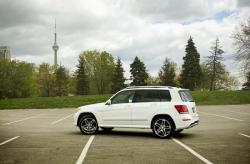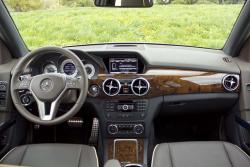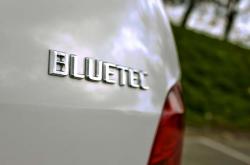  2013 Mercedes-Benz GLK 250 Bluetec Diesel. Click image to enlarge |
Review and photos by Jeff Wilson
Originally published July 18, 2013
In February this year, the recently refreshed Mercedes-Benz GLK 350 was forced into a matchup against a surprisingly diverse but wholly impressive collection of compact luxury SUVs. In that comparison, the Benz earned enough votes from our test team to vault it into second place overall, right behind the Audi Q5.
For me the GLK was the top choice, offering a triumphant mix of interior and exterior styling, enjoyable driving dynamics and all-round functionality that I felt was unmatched in the group. After that brief time with the smallest Mercedes SUV, I was hell-bent on getting my hands on the more affordable diesel variant, the GLK 250 Bluetec, to see if I’d like an even more practical (albeit less powerful) version of this great model.
When the diesel GLK became available in the press fleet, I leapt at the chance to rack up an indecent number of kilometres on the little machine to see if its desirability would wane at all.
As it happens, I can tell you unequivocally that I like the GLK even more now than I did before.
The GLK is now my favourite vehicle wearing the three-pointed-star badge that is not fitted with an AMG V8. It’s the right size for my family of three; its unique styling is very appealing (especially in my tester’s fashionable white colour); it’s properly fun to drive; and it’s all-season practical. But where the 250 outshines its more lively (and costly) 350 sibling is in its remarkable fuel efficiency.
In February, wearing snow tires and driven fairly aggressively all day in a predominantly urban setting, our GLK 350 gulped premium petroleum at an observed average rate of 12.8 L/100 km. After a day of driving 600 km on a deliberately diverse route (ranging from straight highway slogs to back road carving to even a little light off-roading), the GLK 250 sipped diesel at an average rate of 6.5 L/100 km. Six-point-five! For an all-wheel-drive SUV that weighs 1,925 kg! I’ve driven diminutive economy-car penalty boxes that struggle to better that. Heck, in ideal situations on a closed course and driven by magic elves, the GLK is only rated at 5.9 L/100 km on the highway. My overall average for the week with a closer 50/50 mix of city and highway driving still netted a 6.8 L/100 km average. Astonishing.
Surely a large part of the GLK 250’s real-world fuel prowess is its effortless engine. The 2.1L turbocharged I4 gives up nearly a litre and a half in displacement to the GLK 350, which also translates to a 102-horsepower deficit. But before you write the Bluetec off as a complete slug, consider that the little diesel twists out 369 lb-ft of torque from 1,600–1,800 rpm versus the gasoline engine’s 273 at 3,500.
  2013 Mercedes-Benz GLK 250 Bluetec Diesel. Click image to enlarge |
What this means is that the smaller engine makes short work of around-town tootling, pulling the baby Benz around with ease. There is a brief hesitation as the turbo spools up, but once on boost, it’s surprisingly lively. Gearing is the same whether you order the 250 or 350 with the 7G-Tronic Plus seven-speed automatic that issues reasonably crisp shifts and low-rev cruising at highway speeds. The shortage of horsepower versus the 350 is really only felt when executing a pass, which requires a more judicious stomp on the accelerator in the diesel.
Like our previous GLK 350 tester, our 250 Bluetec was shod with handsome 20-inch AMG wheels that really finish off the exterior styling. This is about as macho as a cute-ute is ever going to get. Those wheels, combined with the GLK’s sophisticated suspension tune, help it take to the curves with the aplomb of a C-Class sedan more than an SUV. The ride is a bit stiff when compared to a larger Mercedes ML 350, for instance, but the trade-off for driving enjoyment is well worth it.
Steering feel is pretty decent, too, by modern, electric steering standards, and weighted with that typical German-car heft. The thick-rimmed steering wheel feels great in the hands, wrapped in soft, perforated leather and with just enough buttons to serve the driver’s needs without confounding him or her.
The GLK’s considerable mass becomes evident when trying to bring the car down from highway speeds as the brakes fight the laws of physics. That said, the binders are fully capable, just require a solid push on the firm pedal to achieve best results.











